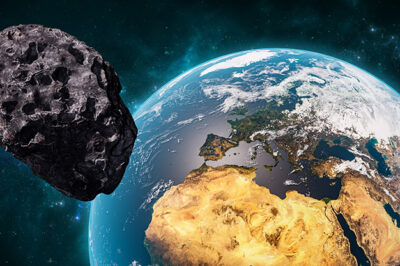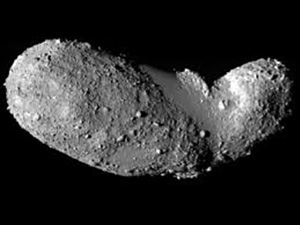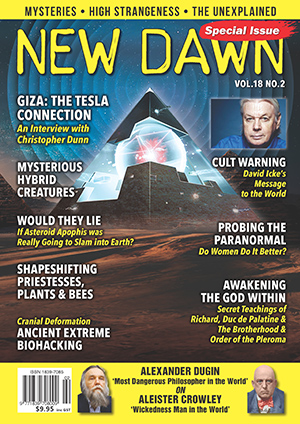From New Dawn Special Issue Vol 18 No 2 (April 2024)
The odds against tomorrow for life on Earth are not good. Genocide in the guise of fake “pandemics”; the collapse of urban population centres; a Third World War… Pick your poison! Singly or a combination of mortal body blows to civilisation are progressively demolishing every aspect of modern culture before our own eyes.
Yet, all these fatal symptoms of a self-destructive society may be thrown into a cocked hat as pathetically puny compared to what the Cosmos has in mind for us.
Potential Collision Course with Earth
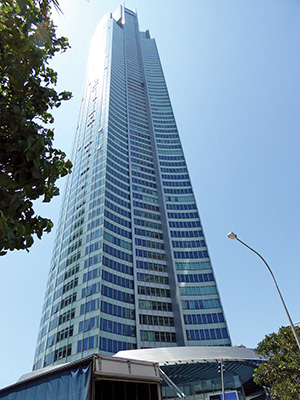
On 19 June 2004, three American astronomers at the Kitt Peak National Observatory in Tucson, Arizona, discovered a peanut-shaped asteroid on a potential collision course with Earth. Because Roy Tucker, David Tholen, and Fabrizio Bernardi determined that the object had a 2.7 per cent chance of hitting our planet during its next orbital pass, they christened the object Apophis, Greek for the Ancient Egyptian god of destruction, Apep. At 370 metres in length, Apophis is larger than Australia’s tallest building, Queensland Number One, by 47.5 metres, with an estimated total weight of 1.1 million tons of solid rock and nickel-iron.1
The stony colossus will travel at speeds between 56,327 kilometres per hour and 72,420 kph after entering our atmosphere.2 Too large for burning up through its frictional descent or in an airburst, its impact will result in a four-gigaton detonation.This is the equivalent of two hundred thousand atomic bombs of the type that destroyed Hiroshima near the close of World War Two. Or eight times the explosive force of Russia’s Czar Bomba, history’s largest man-made nuclear blast, on 30 October 1961, in the Novaya Zemlya archipelago of the Arctic Ocean.3
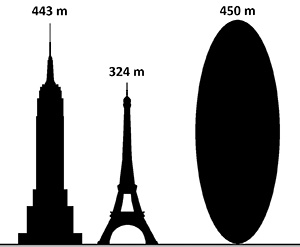
For example, if Apophis strikes downtown Sydney, 2.4 million residents in the metro area will be instantly vaporised.4 Another million victims would suffer second and third-degree burns within a twenty-six-mile radius of the impact zone, while an additional four hundred thousand persons outside the fireball would die from a resulting 272-decibel shockwave.5 Its 1,609-kph winds would claim more than one hundred thousand more lives as they obliterate virtually every man-made structure standing inside a twenty-one-kilometre radius from the blast centre.6 Sixty-three kilometres outside the impact zone and travelling at a reduced speed of 322 kph, the winds would still be powerful enough to take the lives of an additional thirty-five thousand people.7 The only thing to mark where Sydney once stood would be a black, smouldering impact crater, 5.1-kilometres across.8
Repercussions would not be confined to southeast New South Wales, burned by a 129-kilometre-wide firestorm. The two thousand cubic kilometres of debris and ash ejected into the atmosphere by the asteroid strike will block sunlight sufficiently long enough to halt food production on Earth for at least the following two years. Worldwide famine inevitably follows extensive damage to whole eco-systems, with the subsequent collapse of human agriculture.9
As such, Apophis could starve our fragile civilisation to death with a global famine, especially given that mankind’s natural living spaces are already stressed by decades of unrelieved industrial abuse. But we are hardly the first species to have similarly died out, as witness Earth’s previous five mass extinction events, the best known and most comparable example being the infamous asteroid that wiped out the dinosaurs 65.5 million years ago. Accordingly, we can make no claim on uniqueness.
Asteroid Threat is Real
Astronomers have only recently come to realise that our world is circling through a cosmic shooting gallery thick with near misses, twenty-three hundred of which are identified and classified as “hazardous,” capable of colliding with our planet. Apophis is the most threatening of them all due to the unusually extreme nearness of its orbit. Astronomers assure us, however, that possibilities for its collision with any one of mankind’s five hundred and twelve urban population centres inhabited by one million or more residents is statistically impossible. Scholarly memory is short, however.
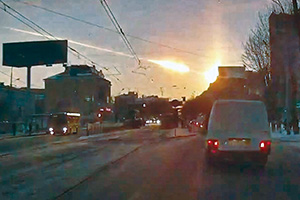
Just eleven years ago, a ten-thousand-ton meteor detonated 23.3 kilometres over the Russian city of Chelyabinsk. The air-burst’s 500 kilo-tonnes of TNT generated were equivalent to America’s “Ivy King” bomb, the largest pure-fission nuclear weapon ever tested by the United States. About fifteen hundred people in and around Chelyabinsk were injured, with one hundred twelve hospitalised, mainly due to flying shards of glass from windows shattered by the exploded object’s shock wave. Three thousand buildings in six cities across the region were damaged by the detonation and impacts.10 Had the 15 February 2013 bolide – which descended at nineteen kilometres per second – blew apart three seconds later, it would have consumed Chelyabinsk’s 1,160,000 residents in a rapid series of cataclysmic events not unlike the hypothetical annihilation of Sydney by Apophis, described above.
It would appear our cities are not immune from heaven-sent destruction. To be sure, most materials from outer space naturally fall into seas or lakes, covering as they do, seventy-one per cent of the Earth’s surface. This is little consolation, however, because the consequences of more than a million tons of solid rock falling at seventeen kilometres per second into a large body of water could be more catastrophic than the obliteration of a single metropolitan area. Some observers – the popular American astrophysicist Neil deGrasse Tyson among them – calculate Apophis may strike the Pacific Ocean, five hundred km west of Santa Monica on Friday, 13 April 2029, at 8:46 p.m., local California time, when it is nearest our planet.11
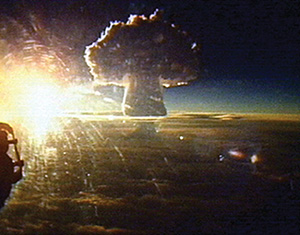
Should a collision occur in that area, the asteroid will cavitate a hole in the sea several kilometres across before exploding. The Sentry Risk Table estimates that Apophis would impact Earth with kinetic energy equivalent to twelve hundred megatons of TNT.12 By way of comparison, the Japanese city of Nagasaki was destroyed in 1945 by a nuclear bomb rated at 1.2 megatons. The tsunami Apophis generates will rear up six hundred metres high to radiate outward in all directions, travelling at more than eight hundred kph. Making landfall in a succession of forty to fifty waves per minute, most forms of human habitation along a thousand kilometres up and down the west coast of the United States would be wiped from the face of the Earth.13 San Diego, Los Angeles, Sacramento and San Francisco will no longer exist. Coastal regions of Canada, Alaska and southwestern Asia, even Australia, but especially the Hawaiian Islands, would experience some serious after-effects. Terrible as the images were of the 2011 tsunami that took at least twenty thousand lives in Japan, they would pale at the prospect of thirty-nine million people killed by Apophis.
What are the Chances?
But is there any realistic potential for such an unprecedented occurrence? Astronomers at America’s Jet Propulsion Laboratory “announced that Apophis has no chance of impacting Earth in the next one hundred years.”14 This from the same people who were blind-sided at Chelyabinsk. They nonetheless concede that no other space rock of its size has more closely approached the Earth in recorded history. So close, in fact, Apophis will be easily visible to the naked eye by millions of observers in rural as well as darker suburban areas.
The outer space visitor will be clearly discernible through ordinary binoculars from most locations, when its brightness peaks at magnitude 3.1, while passing over Europe, Africa and western Asia at only five times the radius of the Earth, ten times closer than the Moon. The asteroid is expected to traverse the surface of our planet at less than twenty-nine thousand kilometres – a hair’s breadth, in astronomical terms – beneath the geosynchronous positions of orbiting communication satellites. To maintain their geo-stationary belt formation, they must maintain a constant altitude of 37,015 kms, which is sufficiently high to escape Earth’s gravity. If the satellites descended eight thousand kms to the level of Apophis during its close encounter, tidal forces would drag them down to destruction, as they can the in-coming asteroid.15
At the very least, its rotation axis will be altered, distorting the orbital path, thereby setting the scene for another scheduled engagement in 2036, when the great bolide will get another, more likely crack at hitting us. Its orbit could be additionally changed by even a partial resurfacing of the object’s surface, a subtle enough alteration causing it to crash, if not in five years, then, with increasing inevitability, sometime in a future return, perhaps no later than during another predicted return in 2068.
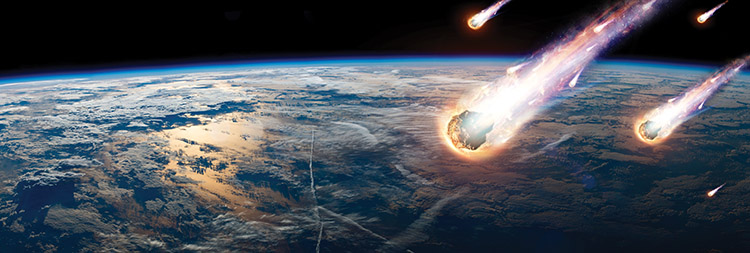
As Apophis streaks downward through the orbits of our 8,337 communications satellites, running into any one of them could engender at least an incremental deflection, nevertheless influential enough to nudge it on a direct heading toward Earth. Their numerical threat pales before the vast field of space junk encircling our planet. There may be as many as 170 million pieces of debris currently in orbit.16 While the vast majority are too small to track due to the limits of current technology, these fragments are no less dangerous. Combined, their numbers alone make at least several collisions with Apophis virtually inevitable. In fact, if the asteroid strikes anything over the next five years, its orbit will be warped potentially into a collision course, given its already close near-miss predicted for 2029.
Then there is the Yarkovsky Effect. Two years before his death in 1902, a Polish-Russian civil engineer, Ivan Osipovich Yarkovsky, discovered how the heating of a rotating object in space causes it to experience a force that, while subtle, leads to significant, long-term distortions in its orbit, particularly that of an asteroid. Its irregular interaction with solar radiation – alternating heating and cooling of opposite sides, as the object spins – effects its trajectory. As Nature magazine reports, “The Yarkovsky Effect is the main source of uncertainty in impact probability estimates for this asteroid.”17
Contributing to the incalculable complexity of its unpredictability is the out-gassing an asteroid undergoes as it nears the sun when rising temperatures elicit trajectory-diverting jets. Endeavouring to factor in all these unstable variables, astrophysicists have found to their dismay that Apophis is shifting its orbital path by one hundred seventy metres per year – a change that will either take it further away from Earth or target our planet. Confirming this indeterminable effect, American scientists at the National Aeronautics and Space Administration (NASA) admit that “radar measurements and ground observation discovered Apophis’ trajectory is gradually deviating from a purely gravitational orbit.”18
Would They Tell Us?
While none of the above data proves Apophis must inevitably strike the Earth sometime later this century, nor does it conclusively eliminate that probability, but, on the contrary, suggests a collision is entirely possible. What it does show is that the slender difference between a near miss and an impact is too close to call.
Doubtless, all this and more are thoroughly recognised by NASA authorities, who may feel they must downplay the bolide as a threat to ally public fears and the consequent potential for social unrest. A sampling of the many comments posted by viewers of various sites that discuss Apophis on Youtube, the internet video-sharing platform, reflects this uneasy uncertainty:
“If it was going to crash into the Earth, they would not tell us, because that would cause panic. I think we will not know the whole truth until a few days before it arrives.”
“So, this is something you shouldn’t worry about? It would be insane chaos and civil unrest if human beings knew of their demise with several years’ notice. I guarantee you that if and when one is on a collision course with earth, you won’t be made aware of it until the people in charge alone tell you that it is. They are definitely downplaying this.”
“If it is going to hit, would they tell us, or keep it secret? Do you think they are going to tell us?”
“Worked for a printing company in the early ‘90s. One day, we were printing the covers for Time magazine that had a picture of this asteroid and doomsday graphics saying it would hit in 2029. But the name they gave it then was Wormwood.19 The run was cancelled half-way thru the shift, and we never heard about it again.”
“And if Apophis was going to hit the Earth with great certainty, do you really think people would be told this? The powerful ones would just leave us in false hope while they prepare their bunkers deep underground.”
“If it was going to hit, they would not tell us. This story will be much different in a few years. Sure, if the variables in place when these measurements were made hold true and nothing changes between now and then, it won’t be life threatening. But that’s a lot of time for things to happen. Its orbit could change from gravity tugs coming from other objects, its mass could change, altering its trajectory. It’s not wise to assume it’ll be the same five years from now, as it is today.”
“I don’t believe the recalculations. I believe they know people would panic. Why would they do this, if they feel it won’t hit us?”
“I’m not convinced that the re-calculations predicting a near miss are conclusive. At that close a proximity, standard deviation in calculations alone cannot unequivocally guarantee no impact in 2029 or 2036, or again in 2068. I have the impression of this being denial of the threat of impact. Or perhaps an attempt to placate everyone.” 20
NASA authorities would be extraordinarily remiss should they fail to attempt some serious means of deflecting Apophis away from a collision, even if they believed in the unlikelihood of such an event.
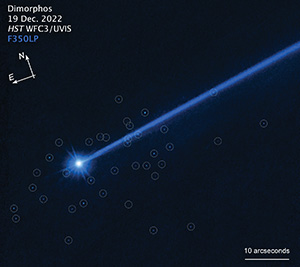
Only two years ago, they deliberately slammed a half-ton DART planetary defense spacecraft into another asteroid, less than half the size of Apophis, at 20,922 kilometres per hour. Their “Double Asteroid Redirection Test” was meant to test theoretical strategy for deflecting similar objects headed for Earth. The strike produced mixed results: while it succeeded in slowing down the target’s orbit around a twin meteoroid by a few millimetres per second, the trajectory of Dimorphos was not budged. Worse, DART unintentionally smashed off thirty-seven large fragments, which were ejected from the surface in a tight pattern resembling buck-shot.
A weapons’ analogy occurred to University of California (Los Angeles) astronomer, David Jewitt: “The boulder swarm [arising from Dimorphos] is like a cloud of shrapnel expanding from a hand grenade. Because those big boulders basically share the speed of the targeted asteroid, they’re capable of doing their own damage.” He added that “given the high speed of a typical impact, a five-meter boulder hitting Earth would deliver as much energy as the atomic bomb that was dropped on Hiroshima.”21
Hopefully, NASA scientists have made effective progress in the development of “planetary defense spacecraft” since the ricocheting Dimorphos affair. If so, they are not talking, at least about 2029’s potentially unlucky Friday the Thirteenth.
“If they say ‘no, we don’t need to worry’,” offers a Youtube commentator, “that means we do need to worry. NASA began by telling us, ‘Apophis has a 2.7% chance of impacting earth’, to, ‘actually, it will definitely pass within 29,000 kilometres, but now has a zero per cent chance of hitting.’’ I smell a monumental rat.”22
SOURCES
1. science.nasa.gov/solar-system/asteroids/apophis
2. news.yahoo.com/nasa-explains-alert-public-apocalyptic-111301382.html
3. Youtube: God of Chaos asteroid more dangerous than NASA admits. Apophis update.
4. Ibid.
5. echo.jpl.nasa.gov/asteroids/Apophis/Apophis_2013_planning.html
6. D. Morrison (6 April 2011). “Asteroid 2004 MN4 will come scarily close to Earth on April 13, 2029, but it will not hit.”
7. Youtube, Op. cit.
8. web.archive.org/web/20130317183119/http://apophisasteroid.net
9. Ibid.
10. planetary.org/articles/what-was-the-chelyabinsk-meteor-event
11. bild.de/regional/berlin/weltuntergang-ausgerechnet-4178182.bild.html
12. cneos.jpl.nasa.gov/sentry/notes.html
13. iopscience.iop.org/article/10.3847/PSJ/ac66eb
14. science.nasa.gov/solar-system/asteroids/apophis
15. mpainesyd.com/idisk/Public/paine_tsunami_asteroid99.pdf
16. nhm.ac.uk/discover/what-is-space-junk-and-why-is-it-a-problem.html
17. nature.com/articles/s43247-021-00337-x
18. Youtube, Op. cit.
19. The New Testament tells how, at the end of the world, “a great star fell from heaven, blazing like a torch, and it fell on a third of the rivers and on the springs of water. The name of the star is Wormwood. A third of the waters became wormwood, and many died from the water because it was made bitter” (Rev 8:10–11). Some alternative researchers speculate the Book of Revelation name describes the common exterior resemblance of multiple-cratered asteroids to worm-eaten wood, thereby inferring that ancient advanced scientific technology in the form of a powerful telescope was accessed by the late 1st Century CE biblical author’s original sources, long before it was re-invented in Holland, in 1608. For further discussion, see the author’s Ancient High Tech: The Astonishing Scientific Achievements of Early Civilizations (2020).
20. Youtube: Apophis Asteroid and Earth at Closest Approach
21. newsroom.ucla.edu/releases/planetary-defense-nasa-dart-mission-asteroid
22. Youtube: Apophis Asteroid – Apophis is Coming in 2029.
© New Dawn Magazine and the respective author.
For our reproduction notice, click here.

